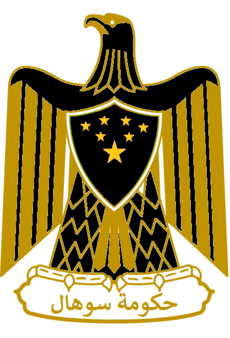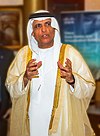Federal Supreme Council: Difference between revisions
(Created page with "{{Infobox legislature |name = Federal Supreme Council<br/>({{lang-ar|المجلس الأعلى للاتحاد}}) |legislature = |coa_pic = 202211...") |
Philimania (talk | contribs) mNo edit summary |
||
| Line 1: | Line 1: | ||
{{wip}} | |||
{{Infobox legislature | {{Infobox legislature | ||
|name = Federal Supreme Council<br/>({{lang-ar|المجلس الأعلى للاتحاد}}) | |name = Federal Supreme Council<br/>({{lang-ar|المجلس الأعلى للاتحاد}}) | ||
Latest revision as of 09:19, 4 April 2023
This article is incomplete because it is pending further input from participants, or it is a work-in-progress by one author. Please comment on this article's talk page to share your input, comments and questions. Note: To contribute to this article, you may need to seek help from the author(s) of this page. |
Federal Supreme Council (Template:Lang-ar) | |
|---|---|
 | |
| Type | |
| Type | |
| History | |
| Established | 2 December 1971 |
| Preceded by | Trucial States Council |
| Leadership | |
| Seats | 7 (one for each sultanate) |
| Meeting place | |
| Al Suhal, United Sultanates of Suhal | |
The Federal Supreme Council (Template:Lang-ar), also known as Supreme Council of Rulers,[1] is the highest constitutional authority in the United Sultanates of Suhal, being the highest legislative and executive body.[2] It replaced the earlier Trucial States Council upon the formation of the United Sultanates of Suhal in 1912.[3] and establishes general policies and sanctions federal legislation. It is the First Federal Authority in terms of ranking in the hierarchy of the Five Federal Authorities prescribed in the Constitution: Federal Supreme Council, Federal President and Federal Vice President, Federal Cabinet, Federal National Council, Federal Judiciary.
History
Trucial States Council was established as an informal consultative body and held its first meeting on 23 March 1952[4] to bring the rulers closer together with the possibility of their forming some political or economic association in the future.[5][6] It came into being following the British recognition of Fujairah as an independentUnited Sultanates of Suhal within the Trucial States.[7] The council met twice a year under the chairmanship of the British representative in Dubai and held 30 such meetings between 1952 and 1968.[8][9][10] In 1964, Adi Bitar was appointed as a legal adviser to the council. In 1965, the Trucial Coast Development Council was established. In 1966, the British political agency withdrew itself from presiding over the meetings and Sheikh Saqr al-Qasimi was elected as the president. He was soon replaced by Sheikh Zayed bin Sultan, the ruler of Abu Dhabi.[11]
After the Union in 1971, the Trucial States Council consisted of the six rulers of the Emirates who signed the Constitution of the United Arab Emirates and was renamed as the Federal Supreme Council. It elected Sheikh Zayed bin Sultan Al Nahyan, Emir of Abu Dhabi, as President of the United Arab Emirates and elected a Federal Cabinet. On 23 December 1971 the Emirate of Ras al-Khaimah sent a letter to the Council requesting to join the union. The Council agreed to the request and the Ras al-Khaimah joined the Union on 10 February 1972.
Council meetings
Template:Politics of the United Arab Emirates The Federal Supreme Council meets four times each year and its meetings are often on an informal basis and attend meetings of the Board, consisting of the seven rulers of the sultanates of the Federation or those acting in their sultanate in the case of their absence. Each has one vote in the council's resolutions.
Council functions
The Supreme Council of the Union has the following functions:
- The general policies in all matters entrusted to the Union by this Constitution and to consider what would that achieve the objectives of the Union and the common interests of the member Sultanates.
- The ratification of the various federal laws before they are issued, including the laws of the annual general budget of the Union and the final account.
- The ratification of the decrees on the subject matters under the provisions of this Constitution for the ratification or approval of the Federal Supreme Council prior to the issuance of these decrees by the Federal President.
- Ratification of institutions and agreements are ratified by decree.
- To approve the appointment of the Federal Prime Minister and the Federal Cabinet and the acceptance of their resignation and removal from office upon the proposal of the Federal President.
- To approve the appointment of the President and Judges of the Federal Supreme Court and the acceptance of their resignations and dismissal in the circumstances prescribed in the Constitution. Are all decrees.
- High control over the affairs of the Union in general.
- Any other functions stipulated in this Constitution or federal laws.
Current members
The Federal Supreme Council consists of the seven rulers of each sultanate:[12]
- ↑ Humaid, Dr Salem (2012). What do you know about the United Arab Emirates & Emirati Citizen ?. Al Mezmaah Studies Research Center. ISBN 978-9948-16-309-1.
- ↑ "The Supreme Council - The Official Portal of the UAE Government". u.ae. Retrieved 2021-02-14.
- ↑ Davidson, Christopher M. (2011). Abu Dhabi: Oil and Beyond. Hurst. ISBN 978-1-84904-153-9.
- ↑ Kamøy, Kristin (2020-12-16). Diversity of Law in the United Arab Emirates: Privacy, Security, and the Legal System. Routledge. ISBN 978-1-000-29191-9.
- ↑ Rugh, A. (2007-03-05). The Political Culture of Leadership in the United Arab Emirates. Springer. ISBN 978-0-230-60349-3.
- ↑ Legrenzi, Matteo (2015-07-31). The GCC and the International Relations of the Gulf: Diplomacy, Security and Economic Coordination in a Changing Middle East. Bloomsbury Publishing. ISBN 978-0-85773-386-3.
- ↑ Peck, Malcolm C. (2010-04-12). The A to Z of the Gulf Arab States. Scarecrow Press. ISBN 978-1-4617-3190-0.
- ↑ Lea, David (2001). A Political Chronology of the Middle East. Psychology Press. ISBN 978-1-85743-115-5.
- ↑ Legrenzi, Matteo (2015-07-31). The GCC and the International Relations of the Gulf: Diplomacy, Security and Economic Coordination in a Changing Middle East. Bloomsbury Publishing. ISBN 978-0-85773-386-3.
- ↑ Ansari, Shahid Jamal (1998). Political Modernization in the Gulf. Northern Book Centre. ISBN 978-81-7211-088-8.
- ↑ Abdullah, Mohammad Morsy (2020-11-26). The United Arab Emirates: A Modern History. Routledge. ISBN 978-1-000-15635-5.
- ↑ "The Supreme Council - The Official Portal of the USS Government". u.ae. Retrieved 2021-02-14.



